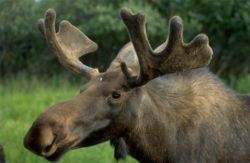Moose
The moose is the world's largest deer. Moose are generally associated with northern forests in North America, Europe, and Russia. In Europe they are called elk. They are most abundant in recently burned areas that contain willow and birch shrubs, on timberline plateaus, and along major rivers. Moose are long-legged and heavily bodied with a drooping nose, a dewlap under their chin, and a tiny tail. Their color ranges from golden brown to almost black, depending upon the season and the age of the animal. The hair of newborn calves is generally reddish brown fading to a lighter rust color within a few weeks. Newborn calves weigh 28 to 35 pounds and within two months grow to over 400 pounds. Males in prime condition weigh from 1,200 to 1,600 pounds. Adult females weigh 800 to 1,300 pounds. Only the males moose have antlers. The plural of moose is moose. The largest moose antlers in North America usually come from Alaska. Trophy class moose are found throughout Alaska, but the largest come from the western portion of the state. Moose occasionally produce trophy-size antlers when they are 6 or 7 years old, but the largest antlers are grown at approximately 10 to 12 years of age. In the wild, moose rarely live more than 16 years.
Moose breed in the fall with the peak of the rutting activities coming in late September and early October. Adult males joust during the rut by bringing their antlers together and pushing. Serious battles are rare. Bulls may receive a few punctures or other damage and occasionally die from their wounds. The winner usually mates with all the females. By late October, once the adult males have exhausted their summer accumulation of fat and their desire for female company, they begin feeding. Antlers are shed as early as November, but mostly in December and January.
The natural predators of moose are wolves, black and brown bears and humans. Black bears take moose calves in May and June. Brown bears kill calves and adults the entire time the bears are out of their winter dens and not hibernating. Wolves kill moose throughout the year.
